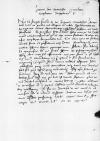Ne tu semper similis es tui, Ioannes Dantisce? Accepi cf. Ioannes DANTISCUS to Cornelis DE SCHEPPER ca. 1526-01-07, CIDTC IDL 6534, letter lost⌊litterascf. Ioannes DANTISCUS to Cornelis DE SCHEPPER ca. 1526-01-07, CIDTC IDL 6534, letter lost⌋ tuas, in quibus me Oedipus mythical Greek king of Thebes⌊OedipumOedipus mythical Greek king of Thebes⌋ esse iubes. Ego vero utinam tuo erga me amori benevolentiaeque orig. benevolentieque⌈benevolentiaequebenevolentiaeque orig. benevolentieque⌉ respondere possem, non dicam satisfacere! Et prius sane de te hanc spem concepi, ut existimarem nihil omissurum esse, quod in rem meam faceret, et nunc mirifice amplexor benignitatem tuam.
De rebus meis uti scribam nonnihil, facit ratio profectionis meae ad vos. Quandoquidem iam mortua illustrissima Isabella of Austria (Isabella of Habsburg, Elisabeth of Denmark) (*1501 – †1526), 1515-1523 Queen consort of Denmark and Queen consort of Norway as the wife of Christian II, daughter of Philip I of Habsburg and Joanna of Castile; sister of Charles V⌊regina principe meaIsabella of Austria (Isabella of Habsburg, Elisabeth of Denmark) (*1501 – †1526), 1515-1523 Queen consort of Denmark and Queen consort of Norway as the wife of Christian II, daughter of Philip I of Habsburg and Joanna of Castile; sister of Charles V⌋ solutus sum liberque. Et magnifice de me sentit illustrissima domina Margaret of Austria (*1480 – †1530), 1501-1504 Duchess of Savoy, 1507-1515 and 1519-1530 Governor of the Habsburg Netherlands; daughter of Emperor Maximilian I of Habsburg and Mary of Burgundy⌊MarguarythaMargaret of Austria (*1480 – †1530), 1501-1504 Duchess of Savoy, 1507-1515 and 1519-1530 Governor of the Habsburg Netherlands; daughter of Emperor Maximilian I of Habsburg and Mary of Burgundy⌋ ipsaque citra interpretem affirmavit me non secus a se Charles V of Habsburg (*1500 – †1558), ruler of the Burgundian territories (1506-1555), King of Spain as Charles I (1516-1556), King of Naples and Sicily, King of the Romans (1519-1530), Holy Roman Emperor of the German Nation (elected 1519, crowned 1530, abdicated 1556); son of Philip I the Handsome and Joanna the Mad of Castile⌊caesareae maiestatiCharles V of Habsburg (*1500 – †1558), ruler of the Burgundian territories (1506-1555), King of Spain as Charles I (1516-1556), King of Naples and Sicily, King of the Romans (1519-1530), Holy Roman Emperor of the German Nation (elected 1519, crowned 1530, abdicated 1556); son of Philip I the Handsome and Joanna the Mad of Castile⌋ commendatum iri, quam optimum e suis familiaribus maximeque praecipuum. Idem Aurei Velleris e written over ad⌈adee written over ad⌉quites, idem nobilissimi quique mihi promittunt neque vanis aut inanibus verbis, sed quod operam quoque meam nonnumquam sibi usui futuram persuadeant. Itaque ad vos paro iter.
Hodie primum ad me delatae sunt cf. Ioannes DANTISCUS to Cornelis DE SCHEPPER ca. 1526-01-07, CIDTC IDL 6534, letter lost⌊litteraecf. Ioannes DANTISCUS to Cornelis DE SCHEPPER ca. 1526-01-07, CIDTC IDL 6534, letter lost⌋ tuae, qui dies est Martii septimus, plus minus duobus mensibus in itinere orig. itinerae⌈itinereitinere orig. itinerae⌉ detentae. Spero alteras a te missas esse, e quibus Charles V of Habsburg (*1500 – †1558), ruler of the Burgundian territories (1506-1555), King of Spain as Charles I (1516-1556), King of Naples and Sicily, King of the Romans (1519-1530), Holy Roman Emperor of the German Nation (elected 1519, crowned 1530, abdicated 1556); son of Philip I the Handsome and Joanna the Mad of Castile⌊caesareae maiestatisCharles V of Habsburg (*1500 – †1558), ruler of the Burgundian territories (1506-1555), King of Spain as Charles I (1516-1556), King of Naples and Sicily, King of the Romans (1519-1530), Holy Roman Emperor of the German Nation (elected 1519, crowned 1530, abdicated 1556); son of Philip I the Handsome and Joanna the Mad of Castile⌋ iudicium et voluntatem intelligam. Tu fac, mi Dantisce, ut me ames, et ad mensem ad te venturum exspecta. Interim non desiste rebus amici[1] consulere prospicereque.
Vale.


 AAWO, AB, f. 10v
AAWO, AB, f. 10v